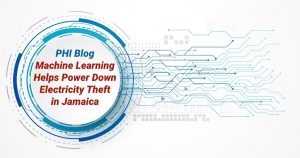Power Theft is a silent crime that causes a huge loss of revenue to power utilities. Despite advanced managerial and technical efforts to crack down on power thieves, power distribution entities are struggling hard to constrain the unscrupulous ways used to steal power. There is no panacea for curbing power theft, and utilities have to develop their own ways.
About a quarter of the electricity produced by Jamaica’s energy utility, Jamaica Public Service (JPS) is stolen. When traditional, labor-intensive methods failed to produce lasting results, Jamaica tried a different approach: machine learning.
Globally, billions of dollars are lost every year due to electricity theft, wherein electricity is distributed to customers but is never paid for. In 2014 alone, Jamaica’s total power transmission and distribution system reported 27% of losses (due to technical and non-technical reasons), close to double the regional average. While the utility company absorbs a portion of the cost, it also passes some of that cost onto consumers. Both actors, therefore, have an incentive to want to change this.
To combat this, JPS would spend more than $10 million (USD) on anti-theft measures every year, only to see theft numbers temporarily dip before climbing back up again. The problem was, these measures relied primarily on human-intensive, manual detection, and customers stealing electricity used more and more sophisticated ways to go around regularly metered use. JPS employees would use their institutional knowledge of serial offenders and would spend hours poring over metering data to uncover irregular patterns in electricity usage to identify shady accounts. But it wasn’t enough to effectively quash incidents of theft.
Now, Jamaica is one of the first countries to use machine learning to tackle its electricity theft problem. The World Bank partnered with Chicago-based data science firm, The Impact Lab, and the Energy Sector Management Assistance Program (ESMAP) to use machine learning to improve JPS’ theft identification process among large and commercial accounts.
A machine learning model needs much less time to scan spreadsheets than a human; even though its algorithm does the same thing that humans do. It uses experience, history, and past results and gradually trains itself to determine suspicious activity. The Impact Lab’s data scientists used employees’ experience with the types of variables to the flag and integrated the model with company data.
Tom Plagge, Co-founder and Chief Scientist of The Impact Lab shared, “Machine learning models oftentimes feel like magic, so we showed staff how these results build on the company’s staff intuition, fit with what they already know through their experiences. It’s like doing what you’re already doing but in an automated, more precise and faster way.”
The project helped JPS to combine machine learning and human intelligence to produce a digital prototype model. Manual theft detection was replaced by time series visualizations, heat maps of usage, and detailed phase information for each account.
According to a recent World Bank brief, Energy Analytics for Development, the data found thousands of large individual and commercial account holders constituted the largest portion of electricity theft. Armed with this information, the strike rate of successful JPS investigations increased substantially, during the first months of its implementation the strike rate had doubled. Motivated by this success, JPS increased their investment in smart grid advanced metering infrastructure (AMI) and combined that with the machine learning model.
“Automating the analysis of daily transactions on electricity accounts will certainly improve the strike rate for detecting and addressing theft,” confirmed Steve Dixon, Director of Transmission & Distribution Asset Management at JPS.
The developed and tested tool is now housed on GitHub’s development platform. Its code is freely useable and ready to be plugged into the accounts’ data of any utility in a situation when a company has a similar problem.
Source Credit: blogs.worldbank.org
For technical and administrative solutions to Power Theft, go for PHI Book Power Theft written by Sreenivasan, an Executive Engineer with Kerala State Electricity Board. He is also an activist in the prevention of power theft. He has been highlighting the issues related to power theft all over the world to create awareness with different perceptions. As a member of the International Utility Revenue Protection Association (IURPA), he has been closely associated with developments in this sector all over the world.
The most striking feature of the book is that it uses suitable photographs to analyse the problems from various angles. It provides a graphic description of the modus operandi of power thieves and uncovers their cleverness and imagination in pilfering electricity
